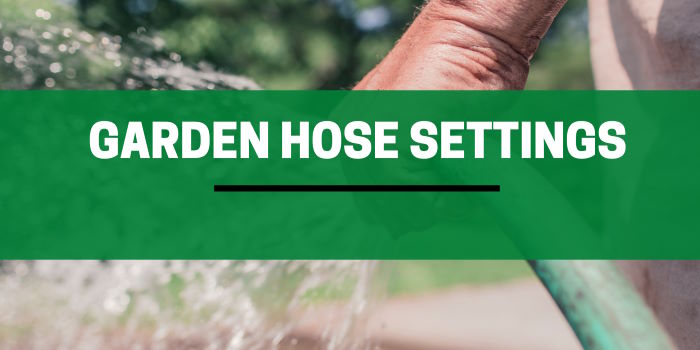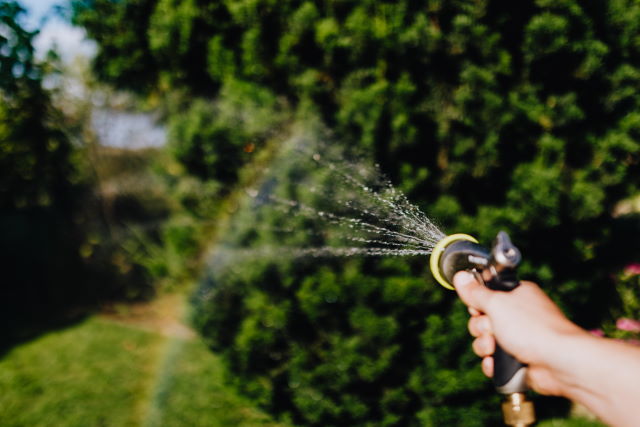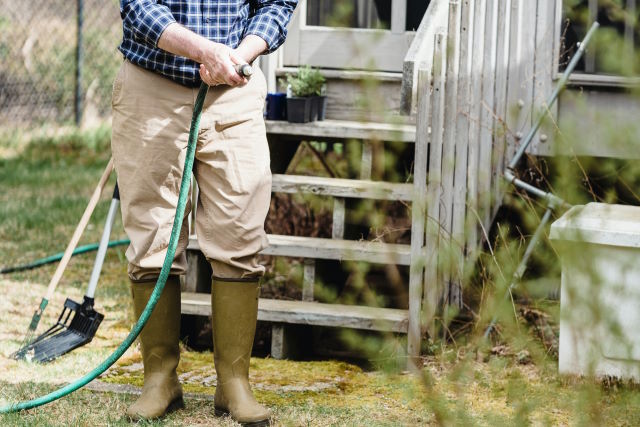
Unsure which are the ideal garden hose settings for your flora and grass?
Here I will cover all essentials on hose nozzle types and mastering water pressure with spray patterns suited for your garden’s requirements.
Drawing from over three decades of gardening passion and armed with a Master’s in Horticulture, I’ve faced every watering challenge imaginable. From nurturing fragile seedlings to satisfying the deep thirst of mature plants, I’ve mastered the techniques for effective watering.
I’ll share my experiences and tips to help your garden thrive.
Contents
Hose Spray Types
For spray-gun modes, choosing the right nozzle shower type is important for achieving optimal results. Each hose spray pattern is designed for different plant types.

Let’s take a closer look at some of the most popular garden hose spray varieties:
Shower Spray
Shower spray is the most common type of garden hose spray and is similar to a shower head. It provides a gentle and even flow of water that is narrow but goes in a wide enough direction.
In my opinion, the shower spray is perfectly fine in most cases. Just don’t spray delicate plants at a close range.
It is ideal for watering delicate plants, newly planted seeds, or general cleaning. If lower water pressure is used, it can provide a tender sprinkle of water suitable for soaking soil or grass.
Jet Spray
Jet spray is a powerful, concentrated stream of high-velocity water perfect for cleaning outdoor surfaces, such as patios, sidewalks, and cars.
But watch out for that splashback.
The jet setting is also useful for removing dirt or debris from hard-to-reach areas.
Fan Spray
Fan or flat spray provides a wide and gentle flow of water from a distance that’s great for watering a large area, such as a flower bed or lawn. It’s also useful for rinsing off outdoor furniture or washing windows.
At a very close range, it can also provide a powerful stream for cleaning.
Cone Spray
Sprays out in a circular cone-shaped pattern starting from the nozzle. This is good for covering a larger area quickly. Think of the fan or flat spray covering a wide horizontal area but the cone pattern covers both a horizontal and vertical area.
Mist Spray
Mist spray provides a fine mist of water that’s perfect for watering plants that require high humidity levels, such as ferns or orchids. It’s also great for cooling down your outdoor space on hot days.
Soaker Spray
A soaker spray is designed to provide a slow and steady flow of water that seeps into the soil. This is ideal for deeply watering plants, such as trees or shrubs, without wasting water or causing soil erosion.
Rain wand
A rain wand is a long, slender nozzle that mimics the effect of rain. It’s ideal for watering hanging baskets or hard-to-reach plants.
Setting The Correct Spray Intensity
When it comes to watering your garden, it’s important to get the correct spray intensity. Too little water and you may be watering your garden for a long time to water it deeply and thoroughly.

A too-high intensity can damage fragile plants and upset the soil.
I personally enjoy taking my time watering my garden as I find it relaxing. But I don’t want to be doing it for so long that my hands start to hurt.
Some nozzles have a switch to lock the trigger in place which is prevents your hands from getting sore during long watering periods.
Here are some tips for setting the correct garden hose spray intensity:
- Know your plants: Different plants have different watering needs, so it’s important to know what plants you have in your garden. Some plants, such as succulents, need less water than others, while vegetables and flowers may require more water.
- Adjust the nozzle: Depending on the type of nozzle you have, you may be able to adjust the water pressure to meet your plants’ needs and avoid damage. Start with a gentle spray and gradually increase the intensity. Stop increasing before it gets to the point where the water pressure is causing the plant leaves to move intensely when the water hits them.
If you are having trouble with too much water pressure in your hose, you may need to look at options to decrease your garden hose water pressure.
Don’t Have A Hose Nozzle?
It’s okay if you don’t have a hose nozzle with spray settings, or perhaps yours is broken. If you don’t mind getting a little water on your hands, you can simply use your thumb to regulate the water pressure and create different shower patterns.
Alternatively, you can place the hose on the ground or near the plant’s base and leave the water hose running for a little while to ensure that the roots will get their required moisture. This is in effect similar to how a soaker hose operates.
Final Thoughts
It’s important to note that some garden hose spray types come with adjustable settings, allowing you to customize the water flow to meet your specific watering needs.
It’s always a good idea to experiment with different spray types to find what works best for your plants. Remember, the right garden hose spray type can make all the difference in maintaining a healthy and thriving garden.
